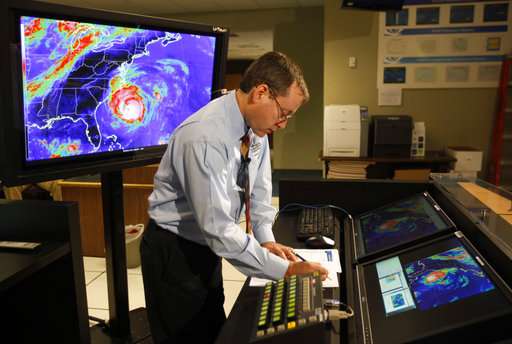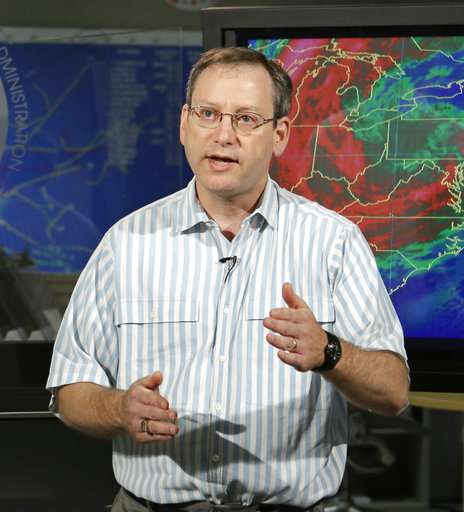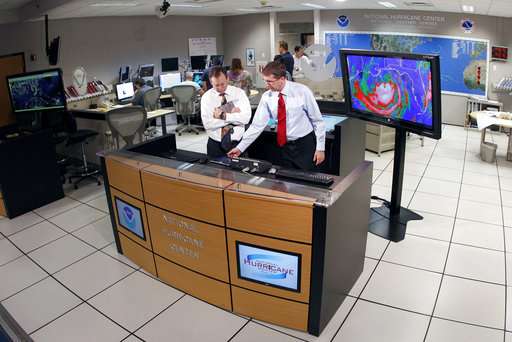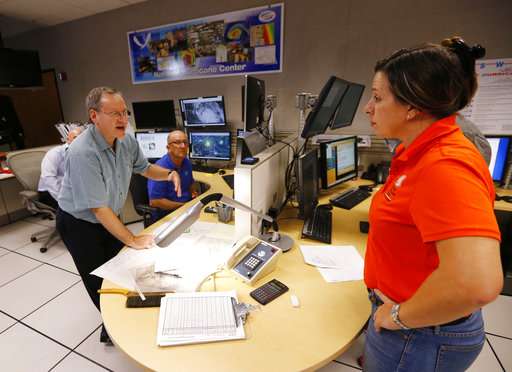Forecaster says budget cuts could hurt hurricane predictions

Recent progress in forecasting the intensity of hurricanes—which has lagged behind storm track forecasting—could be undermined by proposed cuts in federal funding for tropical weather research, says the retiring chief of a team of U.S. hurricane specialists.
The National Oceanic and Atmospheric Administration launched the Hurricane Forecast Improvement Program in 2009 with a $13 million budget. Funding has shrunk to less than half that, and President Donald Trump's proposed budget includes further cuts to NOAA and the National Weather Service.
"It's hanging on really by a thread in terms of funding," said James Franklin, who oversees the National Hurricane Center team that releases tropical storm forecasts and warnings.
During his time at NOAA, Franklin was on research teams that made breakthroughs in tropical storm forecasting and in the understanding of the winds circling a hurricane's eye. His research with dropsondes—sensor-filled tubes that send weather data as they fall through hurricanes—helped improve forecasts of storm tracks and led NOAA to buy a "hurricane hunter" jet that's still used today. He also helped develop new GPS dropsondes that showed how eyewall winds vary.
Before his June 30 retirement, ending a 35-year NOAA career that included 83 flights breaching hurricane eyewalls, Franklin discussed forecasting with The Associated Press:
___

UNEVEN FORECAST IMPROVEMENTS
Hurricane track forecasts have steadily improved partly because the weather elements that direct a storm's path are easy to see, Franklin said. For example, a high-pressure area over the Atlantic known as the Bermuda High, which can nudge storms toward land instead of over open waters, is hundreds of miles (kilometers) across.
However, forecasting intensity has been more difficult because it depends on the interactions between the ocean and thunderstorms at the core of a tropical storm, and those interactions happen in an area just tens of miles (kilometers) wide and are difficult to observe even with advanced dropsondes, drones and satellites, Franklin said.
"We've always been able to see many or most of the steering factors or steering features in the atmosphere, and we get better at it all the time," he said.
"But when it comes to intensity, what's going to make a tropical depression strengthen into a hurricane—now you're talking about all kinds of things going on in the atmosphere on very small scales. You're talking about the interface between the ocean and the atmosphere. How much heat is going to get extracted from that ocean? That's a big driver for intensification."
___

DESPITE FORECASTS, USE CAUTION
Improved forecasts, however, can be a double-edged sword, Franklin said. Despite a variety of warnings and advisories highlighting specific storm hazards, such as storm surge flooding, some people still expect hurricanes to stick to a predicted track, even though forecasts include a range of potential outcomes.
"I find this surprising because there's still so many bad forecasts out there—ours included—yet we see it over and over: people don't have a good grasp on just what the forecast uncertainties still are," he said.
___
POTENTIAL STORM ADVISORIES
The hurricane center issued its first advisories for potential tropical cyclones in June, alerting the U.S. Gulf Coast and Venezuela's Caribbean coast to strong winds and heavy rains a full day before tropical storms Bret and Cindy were officially named. Franklin said those advisories reflect both forecasting improvements and the hurricane center's emphasis on potential risks for communities in a storm's path.

"As the models got better and as the data got more plentiful, the models became much more capable of forecasting formations of storms," he said. "If you're going to do advisories on potential tropical cyclones, you really need to have a good handle on which ones are going to develop and which ones aren't, so it was that science advance that allowed us to do that. I don't think we could have done potential tropical cyclone (advisories) 10 years ago."
___
SEVEN-DAY FORECASTS?
The hurricane center only issued two-day forecasts when Franklin began working for NOAA's Hurricane Research Division in 1982. Five-day forecasts were introduced in 2003. The hurricane center has practiced creating seven-day forecasts for several years, but Franklin said they still aren't accurate enough for public use, and he's skeptical that they'd be useful to coastal communities.
"I'm not in a hurry to do a public seven-day forecast. There's not a lot you can do seven days in advance," he said. "The emergency management community is not telling us that this is important for them."
© 2017 The Associated Press. All rights reserved.

















